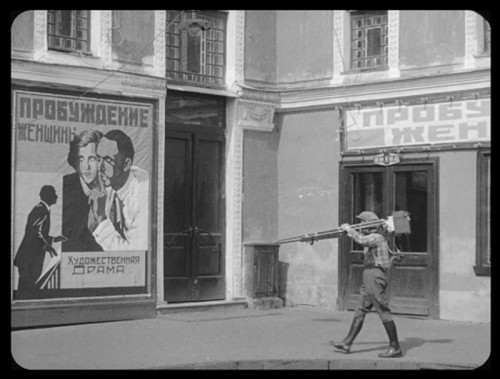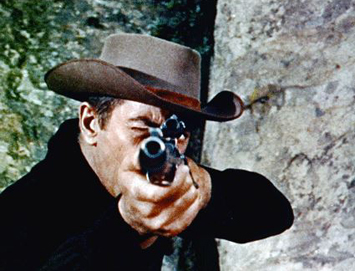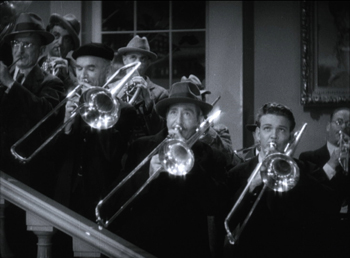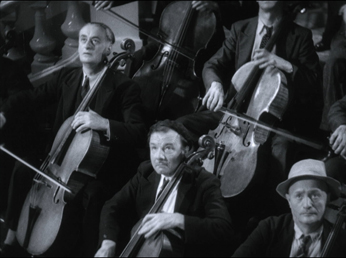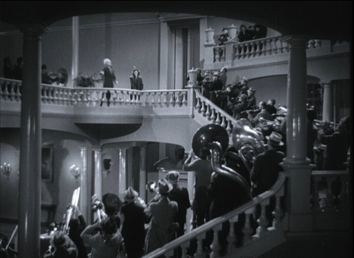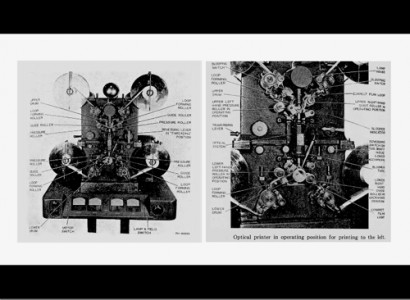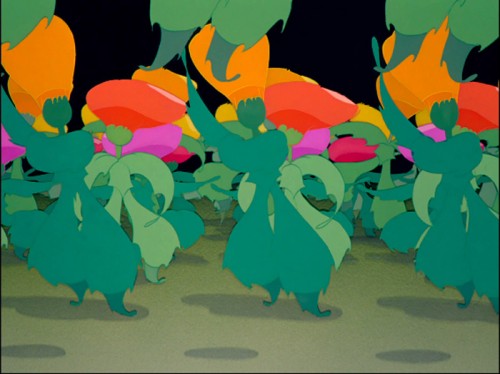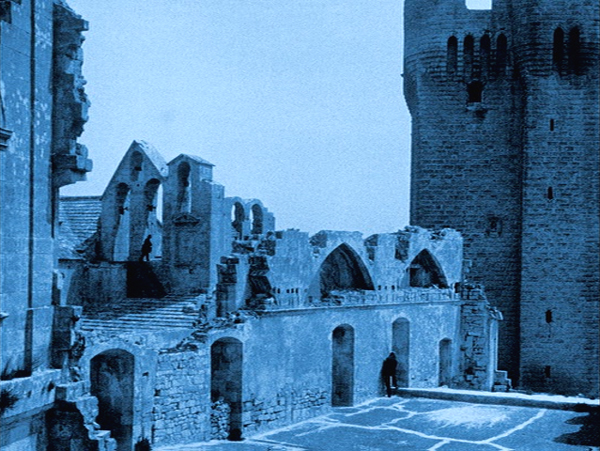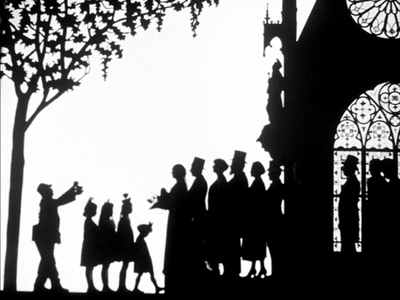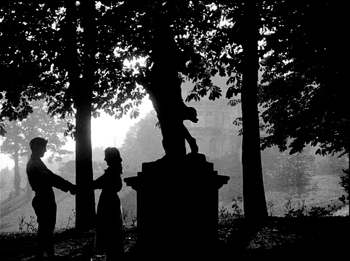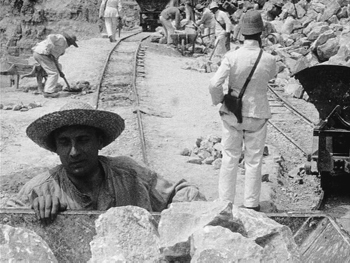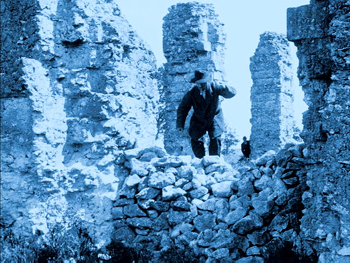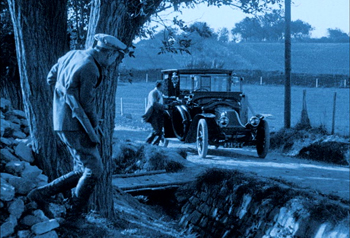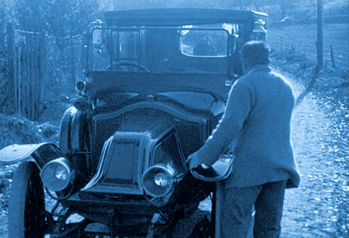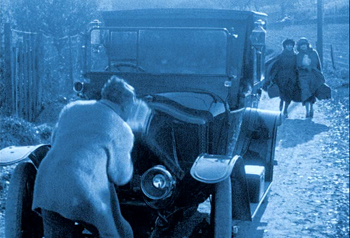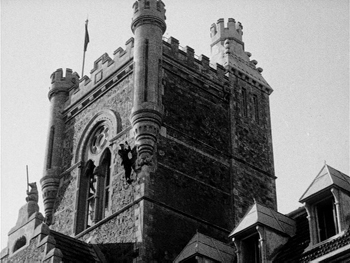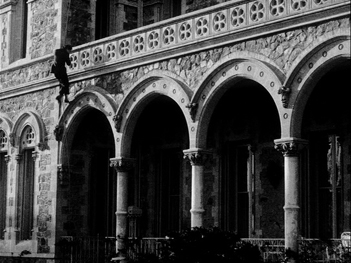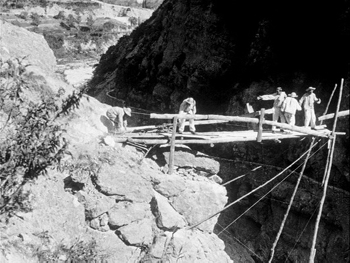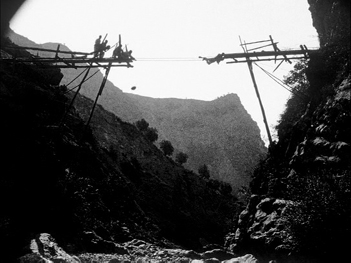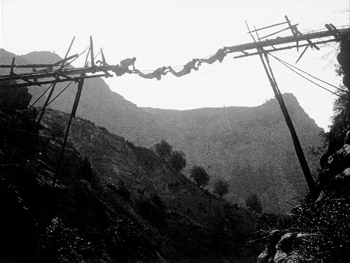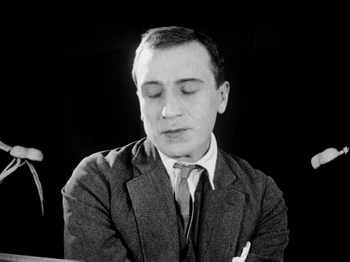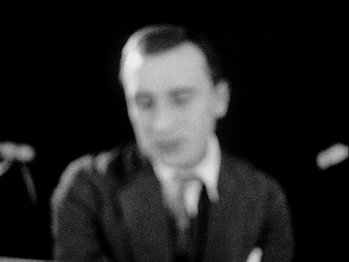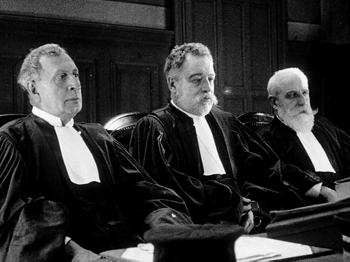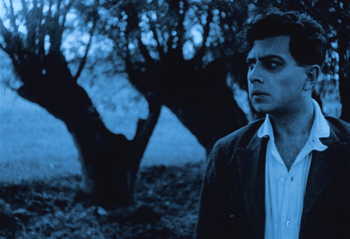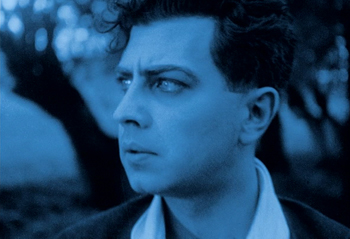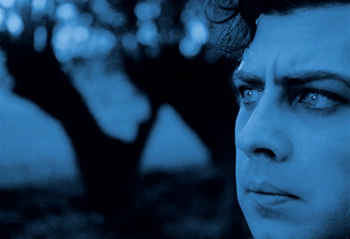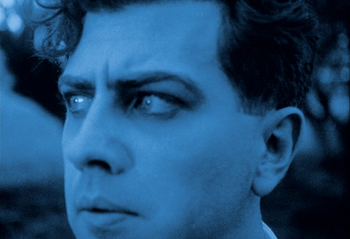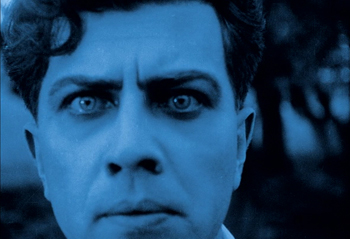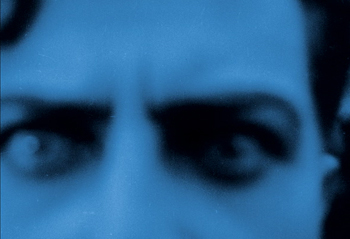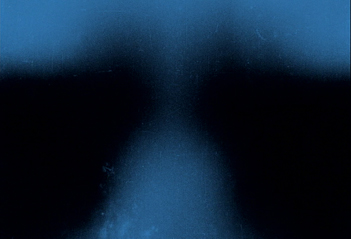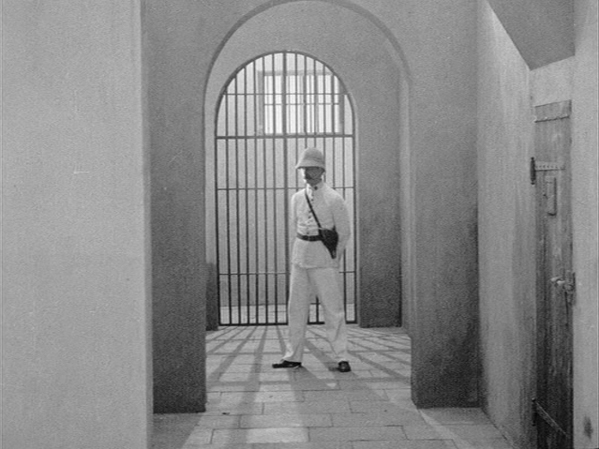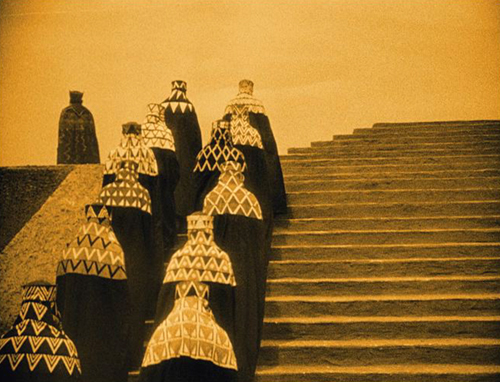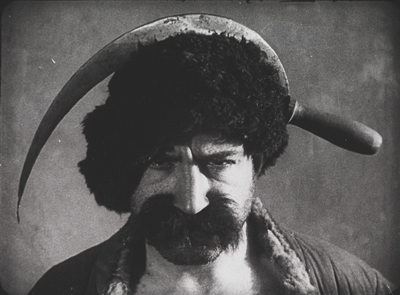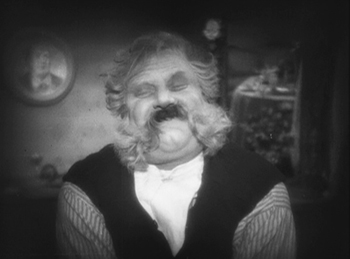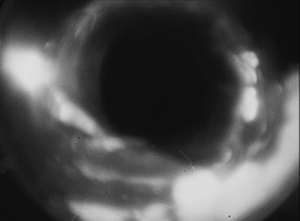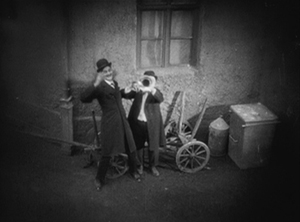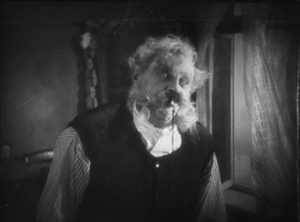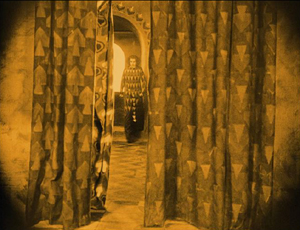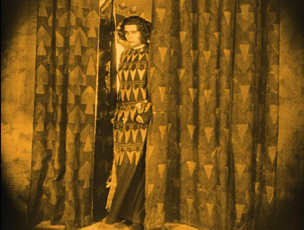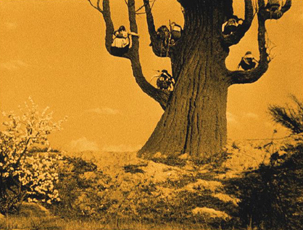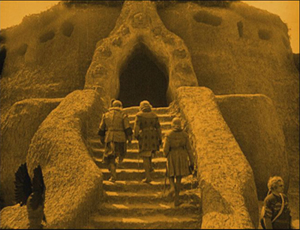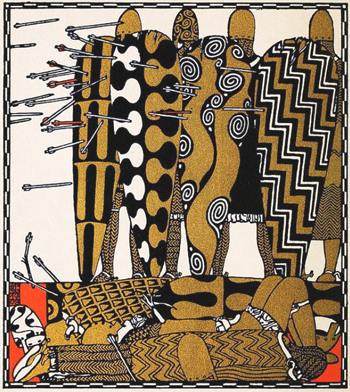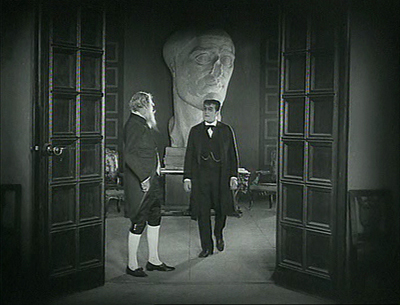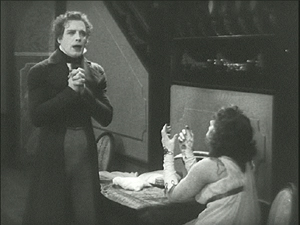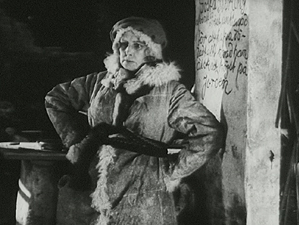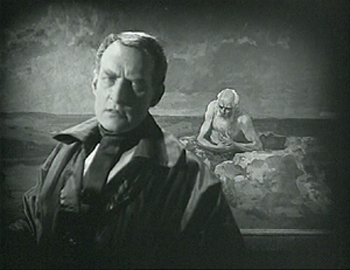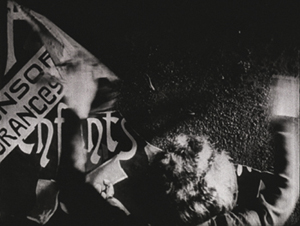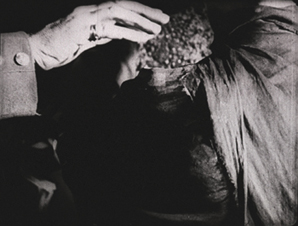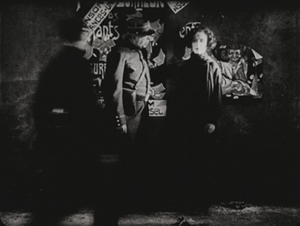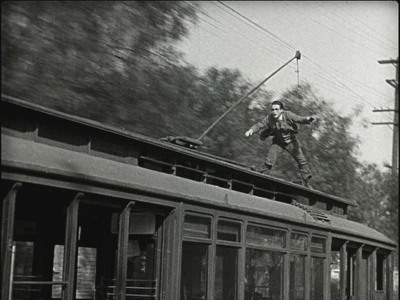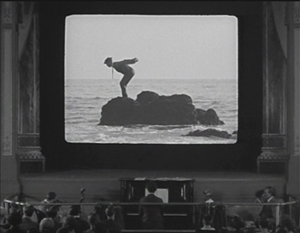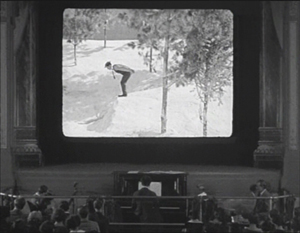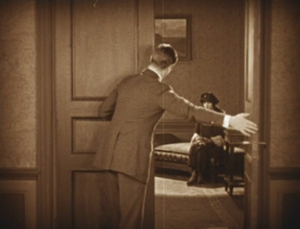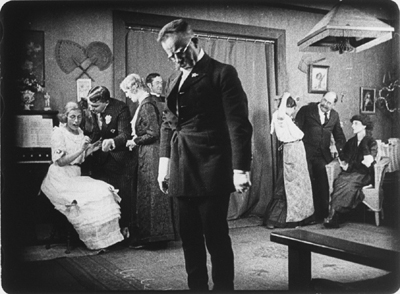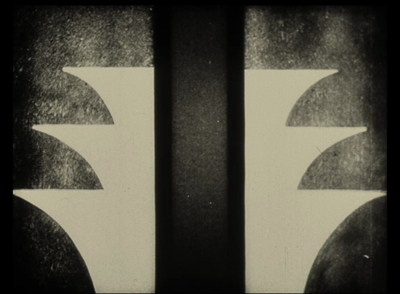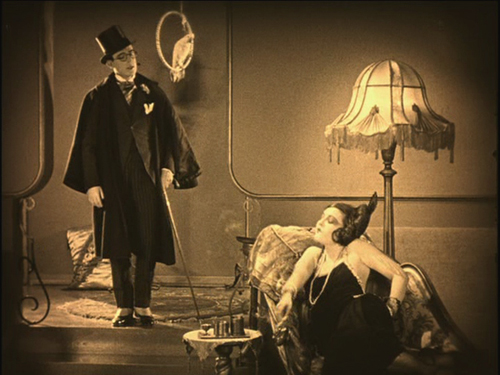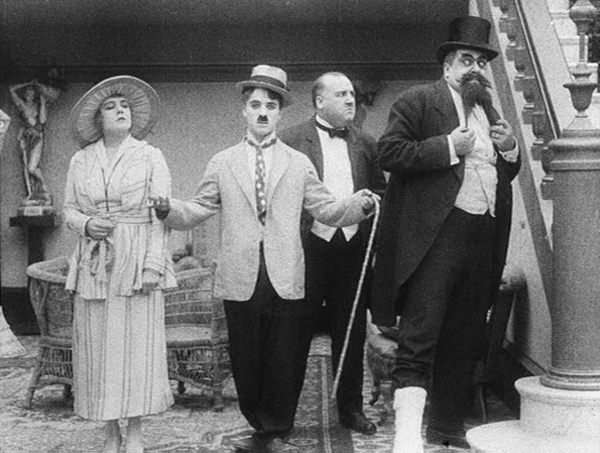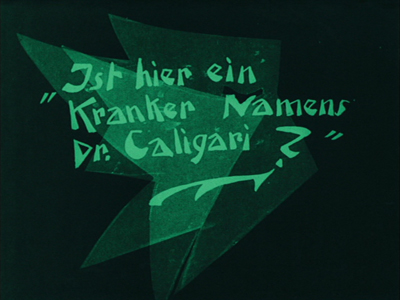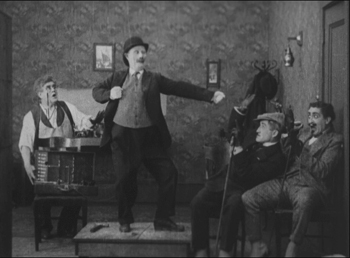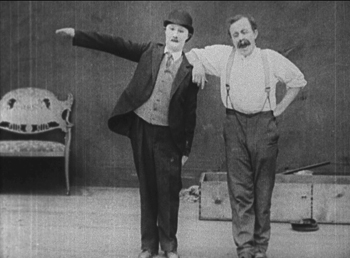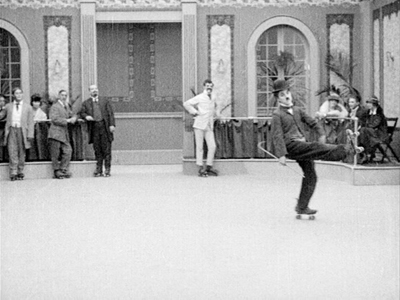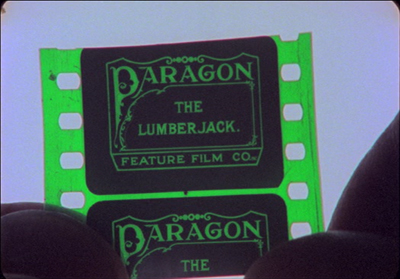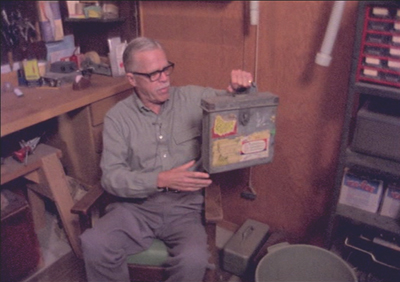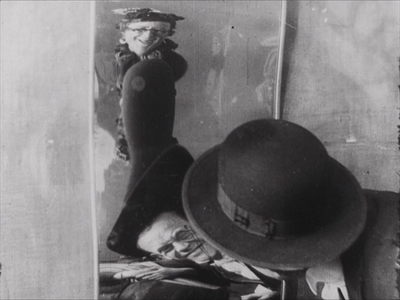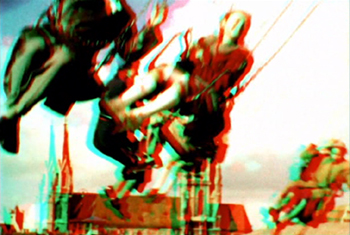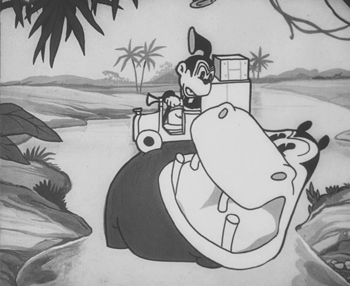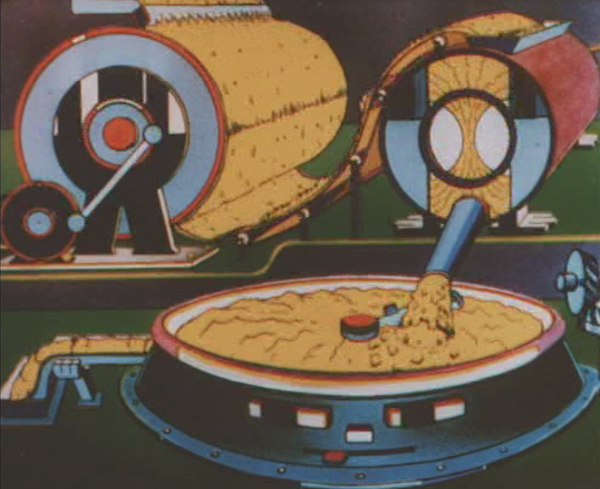Archive for the 'DVDs' Category
Vertov, sound technology, and 3D: Recent Blu-ray releases
The Man with a Movie Camera.
Kristin here:
Every now and then we accumulate a few new DVDs and Blu-ray discs and write up a summary of each. This entry is the first time when all the discs discussed are Blu-ray. In fact, none of these releases is available in the DVD format.
Vertov and more Vertov
Soviet director Dziga Vertov is known primarily for The Man with a Movie Camera (1929), one of the most revered silent films. It is a documentary, an experimental film, a city symphony, and a witness to Soviet society in the late 1920s, all in one. Flicker Alley has done great service to silent Soviet cinema with its Landmarks of Early Soviet Cinema and the serial Miss Mend by Boris Barnet and Fedor Ozep. Now it has brought out a Blu-ray disc of a remarkable 2014 restoration of The Man with the Movie Camera.
This version is based largely on a print struck from the original negative and left by Vertov with the Filmliga of Amsterdam, an early cine-club. It subsequently passed to the Nederlands Filmmuseum. The restoration added clips culled from other archival prints to fill in gaps in this copy, producing an edition that will be a revelation to many who are used to the scratchy, contrasty, and cropped prints that have circulated for decades.
For one thing, seeing that missing left side of the frame makes a big difference. A booklet included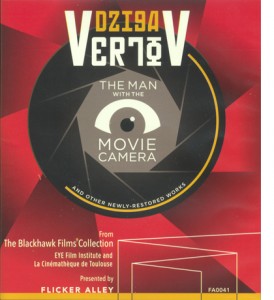 with the disc points out that modern versions are usually taken from sound prints of the film, which required that the left portion of the frame be reserved for the sound track. As a result, that area of the image was cropped out. This new release restores the full-frame original, and the result is dramatically different from earlier versions. Its visual quality is also impressive (see top).
with the disc points out that modern versions are usually taken from sound prints of the film, which required that the left portion of the frame be reserved for the sound track. As a result, that area of the image was cropped out. This new release restores the full-frame original, and the result is dramatically different from earlier versions. Its visual quality is also impressive (see top).
Yet Flicker Alley has been too modest in emphasizing this as a release simply of The Man with a Movie Camera. The full title of the release is “Dziga Vertov: The Man with the Movie Camera and other Newly-Restored Works.” Yet the “Other Newly-Restored Works,” featured in very small print on the cover, are hardly incidental. They include features that many researchers and cinephiles have long wished that they could view in good prints–or any prints at all.
These other works include most of Vertov’s famous features of the 1920s and early 1930s: Kino-Eye (1924), his first feature; Enthusiasm: Symphony of the Donbass (1931), his first sound feature; and Three Songs about Lenin (1934), a celebration of the tenth anniversary of the death of Lenin.
I don’t think any of these films is as important as The Man with the Movie Camera. For me, Kino-Eye is the most charming, with candid depictions of peasant festivals and the like. It was Vertov’s first opportunity to stretch his ambitions after years of work in newsreels and documentaries. It has a spontaneity that perhaps disappeared in the later features.
The disc includes an informative booklet that discusses both the films and their restorations. As an extra, there is the 1925 Kino-Pravda newsreel episode that Vertov made to commemorate the first anniversary of Lenin’s death. It incorporates rare newsreel footage of Lenin, cutting it together in ways that look like modern gifs.
The visual quality is inevitably variable, with the earlier films looking contrasty, but these are no doubt the best versions that we are likely ever to have. This Man with a Movie Camera supersedes the one from the BFI (in the UK) and from Kino (in the USA), though many will want to have the latter for its lovely score by Michael Nyman. The Flicker Alley version has a very different, but highly appropriate, score by the Alloy Orchestra.
Not all of Vertov’s early features are included. For those who want more, Edition Filmmuseum’s release of A Sixth Part of the World (1926), The Eleventh Year (1928), both with a Michael Nyman score, and one shorter film plus a documentary on Vertov, remains a necessity.
3D curiosities
Flicker Alley has also developed a specialty in releasing DVDs and Blu-rays exploring film formats. The company has paid particular attention to Cinerama (This Is Cinerama, Cinerama Holiday, South Seas Adventure, Windjammer, Seven Wonders of the World, and Search for Paradise). Now, in celebration of the centennial of 3D exhibition , it branches out into 3D with 3-D Rarities, described as “A Collection of 22 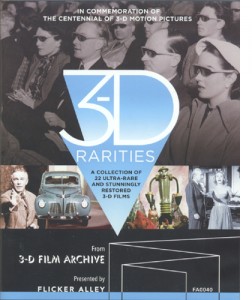 Ultra-rare and Stunningly Restored 3-D Films.” (Since we cannot reproduce 3D frame enlargements, the images below are taken from the Flicker Alley webpage just linked.)
Ultra-rare and Stunningly Restored 3-D Films.” (Since we cannot reproduce 3D frame enlargements, the images below are taken from the Flicker Alley webpage just linked.)
This BD brings together a thoroughly heterogeneous collection of short items, assembled into two programs. The first, “The Dawn of Stereoscopic Cinematography,” covers the years from 1922 to 1952, with short films made outside mainstream Hollywood. Some test footage by Edwin S. Porter and William E. Waddell shown in 1915 no longer survives, so the earliest films on the program are “Kelley’s Plasticon Pictures” (1922-23), including Thru’ the Trees, a travelogue of Washington, D. C. featuring shots of famous buildings framed primarily by foreground tree branches to create planes in depth.
The items that follow range from promotional films to animated shorts to a burlesque comedy featuring two fairly tame striptease segments and two fairly unfunny comedians. A 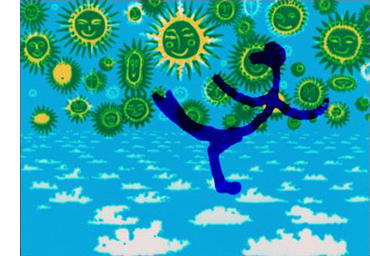 promotional film for Chrysler shown at the New York World’s Fair (New Dimensions, 1940) traces the assembly of a new Plymouth in great detail and with impressive animation, with the parts hopping around and sliding into place on their own.
promotional film for Chrysler shown at the New York World’s Fair (New Dimensions, 1940) traces the assembly of a new Plymouth in great detail and with impressive animation, with the parts hopping around and sliding into place on their own.
For many the highlights of this first program will be four shorts from the National Film Board of Canada, two of them by Norman McLaren. The first, Now Is the Time (1951), uses the filmmaker’s familiar drawn-on-film style (right), while the second, Around Is Around (1951), employs an oscilloscope to create more abstract patterns.
Films by two of McLaren’s colleagues are also included: O Canada (1952) by Evelyn Lambart and Twirligig (1952) by Gretta Ekman. These films are among the only ones on the whole program where objects are not thrust or thrown “out” at the audience.
The first program ends with an advertisement, Bolex Stereo (1952), a camera which supposedly was going to bring 16mm 3D home-movies into people’s living rooms. The complicated technology demonstrated shows why the idea did not catch on.
The second program, “Hollywood Enters the Third-Dimension,” consists mainly of trailers interspersed with a few shorts. The trailers include It Came from Outer Space and Miss Sadie Thompson (both 1953). One fascinating film is Rocky Marciano vs. Jersey Joe Walcott (1953), and I say this as one who has no interest in boxing. This 16-minute black-and-white film starts at the training camps of the two opponents and moves on to the match itself, in which Marciano famously knocked out Walcott in less than two minutes. The in-ring controversy over the call occupies the last part of the film, giving the whole thing a distinct dramatic shape. Multiple-camera filming and 3D add visual interest.
Stardust in Your Eyes (1953), a comedy short starring comic and impersonator Slick Slavin (aka Slaven in the credits), is said in the program notes to have been “a big hit at 3-D festivals. Judge for yourselves, but I advise keeping a finger on the next-chapter button for this one.
Few of these shorts can be said to be important classics of the 3D repertoire, but overall one gains a sense of the surprising range of films made with the process. One also learns that thrusting guns, spears, swords, and even sling-shots toward the audience, as well as throwing stones and other missiles at them, never grow old as far as the makers of these films are concerned. We have a pistol aimed at us in one of the “Kelley’s Plasticon Pictures” from 1922 (below left) and a rifle in the trailer for Hannah Lee (1953, right).
At least we now have the 3D version of Mad Max: Fury Road to recharge this particular visual trope in highly original ways.
Sound marches on
Way back in 2008, when this blog was a mere two years old, I reported on the first volume of a two-disc set of DVDs inaugurating the highly ambitious project, A Century of Sound: The History of Sound in Motion Pictures. That first volume covered the period to 1932. This one is entitled “The Sound of Movies: 1933-1975.” There was of course a lot more recorded sound in that period, and the new set stretches to four Blu-ray discs, for a total of over twelve hours of running time.
I can’t claim to have watched all those hours, but every section I sampled boasted extraordinary amounts of information. Robert Gitt, who originated the project with a 1992 lecture, again narrates. The coverage includes a huge number of rare diagrams, photographs, documents, and demo reels. In addition, many of the chapters add clips from films that contained the most innovative sound techniques of their day. The Garden of Allah, Okhlahoma!, Medium Cool, and many other titles are excerpted in superb copies.
The set as a whole is a gold mine for specialist researchers and technology buffs. The discs include long and detailed passages on such topics as push-pull recording and noise reduction, the latter a crucial challenge to the sound-recording industry for decades. Teachers who searched assiduously could find many clips suitable for classroom use.
A fair amount of the material ought to be interesting to nonspecialists too. For example, the third disc includes a history of early multi-channel and directional sound. The section on early stereophonic systems is fascinating, with its coverage of Leopold Stokowski’s participation in the two most important early films to introduce this new technology to a popular audience: 100 Men and a Girl (1937) and Fantasia (1940). We get generous clips from each. From 100 Men and a Girl, we see most of the famous scene in which an orchestra plays on different levels of Stokowski’s house and multiple channels allow sonic “close-ups” of each type of instrument over close views of that section of the orchestra:
A thorough history of Fantasia includes the image below, typical of the sorts of material The Century of Sound presents: the Fantasound optical printer invented in order to print the multiple optical tracks used for the film’s stereo.
And someone obviously could not resist including a goodly dose of the short dances from the Nutcracker Suite section of the film (see bottom).
The Century of Sound is not for sale commercially. It “is available free of charge to educational, archival and research institutions and to qualified individual educators, researchers and scholars as a not-for-profit educational resource.” There is a modest fee for shipping. For information on ordering, write to CenturyofSound@cinema.ucla.edu.
Flicker Alley’s release of This Is Cinerama provoked David to a survey of Cinerama aesthetics in an earlier entry.
Fantasia.
A legendary film returns from the realm of the lost
Kristin here-
Nearly two years ago, when Flicker Alley released its wonderful collection of French films made by the Russian-emigré production company Albatros in the 1920s, I wrote, “Now, if Flicker Alley will manage to release its long-rumored project, Albatros’s 1923 serial, La Maison du mystère, starring Mosjoukine, we will all be doubly grateful.” That release arrived yesterday.
For decades, La Maison du mystère remained one of the fabled lost films of the silent era. It was an enormous popular success upon its release in 1923, and critics praised it as well. Even Louis Delluc, who highmindedly promoted cinema as a realistic, restrained art, grudgingly said of it, “La Maison du mystère is a serial. They are a necessity. So be it. This one is intelligent, sober, frank, genuinely human.”
Watching the film today, “sober” seems an odd term. Despite its many arty moments, the film presents a conventionally melodramatic story, with Mosjoukine playing a struggling factory owner betrayed by a villainous “friend” who is secretly in love with his wife. He is falsely accused of murder, presumed dead after an escape from hard labor, and operates under various disguises. Blackmail, flashy escapes, a suicide pact, and flagrant coincidences all play roles. Yet in contrast to the fantastical ones of Louis Feuillade from the 1910s, the ones we are most familiar with today, Le Maison du mystère paid more attention to characterization and moved at a less breakneck pace. (Feuillade had moved into this sort of dialogue-centered melodrama himself in the 1920s, as in Les Deux Gamines, 1921, but these films are rarely watched today.)
With Alexandre Volkoff directing the script he and Mosjoukine adapted from a popular novel, filming began in the summer of 1921. At the beginning of 1922, Mosjoukine contracted typhoid fever and was out of commission for six months. Shooting was completed in the summer of 1922, and the film was released in ten weekly episodes starting in March of 1923. Ultimately, like so many silent films, it disappeared.
Severely abridged feature-length versions existed in some places. An 18-reel print discovered in the Iranian archive was destroyed in a fire before it could be sent to France for restoration. Luckily, the original negative turned up at the Cinémathèque française, having been donated in the collection of Alexandre Kamenka, the producer who took over Joseph Ermolieff’s company in 1922 and turned it into Films Albatros. After restoration, the film was shown at Il Cinema Ritrovato in 2002–well before we began our annual visits to that festival in Bologna. It was presented again at the Museum of Modern Art in 2003.
The Flicker Alley release runs 383 minutes and seems to be essentially complete, although the intertitles apparently are replacements. Unlike so many restorations derived from worn release prints, this one is visually gorgeous. It’s mostly in black and white, though it has appropriate tinting for fire and night scenes. Neil Brand provides an excellent piano score.
The old and the new
Like so many of the major French films of the 1920s, especially the Impressionist ones, La Maison du mystére combines a sentimental, old-fashioned story with unconventional stylistic devices: unusual pictorial motifs, beautiful cinematography and design, and imaginative staging. It is probably this visual interest that led to the film’s original acceptance by reviewers and to its enthusiastic reception by modern historians and silent-film buffs.
One visual motif that begins early on is silhouettes. The opening involves Mosjoukine’s character, Julien, still a bumptious, naive young man, courting Régine, the daughter of a wealthy couple who live near his chateau (the “maison” of the title). Despite his shyness, they manage to become engaged and walk joyfully through the woods together.
The entire wedding scene is then compressed into a series of shots done against bright white backgrounds render the actors and settings in near-black silhouettes (above). The result looks like a live-action version of a Lotte Reiniger cut-out animated film.
As I discussed in my entry on the Albatros DVDs, the settings in the studio’s films tended to be impressive as well. Here much of the interest is created by actual locales. David speculated that the whole film was conceived around the ruined fortress or castle where several scenes take place. That’s not likely, but the filmmakers used the ruins well. Rudeberg, a woodcutter whose penchant for amateur photography leads him to photograph the murder of which Julien is falsely accused and convicted, hides the prints in this castle. Rather than turning them over to the authorities, he is using them to blackmail the real murderer, the factory manager Corradin. Corradin twice follows him to the castle, leading to dramatic compositions of the two men in different parts of the frame. In the image at the top, Corradin slinks along the row of arched doorways at the bottom, while Rudeberg is visible moving through a higher archway at left center.
Alexander Lochakoff, the main designer for Ermolieff and then Albatros, was somewhat restricted by the story. He needed to provide realistic interiors for an antique-filled chateau rather than the modern apartments in which some of the other Albatros films take place. Still, he managed some characteristic designs, such as the prison corridor at the bottom of this entry, a location seen only in one brief shot.
There are some brilliant moments of staging in depth. After Julien is sentenced to twenty years of hard labor, his new situation is introduced via a tracking shot with the camera atop a cartload of stone which he is pushing. Gradually the laborers breaking stone and the guards overseeing them are revealed (below left). In another shot in the ruins where Corradin is tailing Rudeberg, he is glimpsed in the background (below right).
In a scene late in the film, Julien plans to flee with Régine and their daughter Christiane. He is dressed as their chauffeur, but Corradin shows up and spots the car. Julien hides and watches him from behind a tree in the foreground.
We then see the two women approaching, framed through the back window of the car and watched by Corradin, in the foreground. He ducks down and pretends to fiddle with the car’s engine to prevent their realizing who he is as they draw near.
I could go on illustrating such stylistic flourishes, but I leave it to you to find them for yourself. There’s a very early example of a montage sequence to compress the passing of World War I into a series of titles, from 1914 to 1919, superimposed over stock footage of combat, and a marvelously choreographed high-angle scene in a forest as a troop of policemen pop out of nowhere to surround and arrest Julien.
All serials need stunts
Much of the film consists of conversations and confrontations among the characters, a trait which no doubt led critics to contrast the more action-oriented serials of recent years. Still, there are two sequences where derring-do takes over. After the police arrest Julien, he makes an escape via a rope down the tower and wall of his chateau, a feat accomplished in a single take tilting down to follow his progress.
Later, in an episode entitled “The Human Bridge,” Julien and four of his fellow prisoners escape from their guards while working on a railroad track. This lengthy sequence involves first the commandeering of a passing train and then a chase over an area of rocky crags. At once point the escapees find the rickety remains of a tall bridge above a river gorge and fling ropes across. The four other prisoners then lie end to end, clinging to the ropes, forming a bridge to allow Julien, who has been wounded during their flight, to cross over. One extreme long shot of the scene shows two of the men’s hats falling off, demonstrating as they drift down to the bottom that there is no trick photography involved. It is certainly as impressive as any of the stunts in Feuillade’s films.
Touches of Impressionism
La Maison du mystère certainly cannot be characterized as an Impressionist film. Yet the movement was beginning to expand in 1921, and there are some moments of subjectivity that draw upon its newly minted conventions. As his trial is drawing to an end, Julien closes his eyes, and the shot goes out of focus. We see a series of quickshots of his surroundings and his family as he seemingly recalls the events of the trial as a montage scene. Finally the same framing of Julien shows him coming into focus.
This is a fairly straightforward Impressionist device, but a more daring suggestion of a subjective state occurs much later. Julien’s daughter Christiane and Rudeberg’s son Pascal have fallen in love, and they vow that if they cannot marry each other, they will both commit suicide. When the villainous Corradin forces Christiane to agree to marry him, Pascal sets out to drown himself. His distraught state of mind is conveyed in a single shot as he walks toward the mill pond and hesitates. As he moves into the shot, he is framed in a standard medium close-up. As he hesitates, however, he moves unusually close to the camera and then backs partway out of the frame, as if afraid to continue. Finally he turns and stares into the camera, moving forward out of focus until his dark-shadowed eyes fill the frame. The implication is that he determines to go on with his plan.
(Fans of Evgeni Bauer will recognize Vladimir Strizhevski, the son in the director’s final film, The Revolutionary.)
Star turn
Apart from the imaginative staging, cinematography, and design, La Maison du mystère is full of fine performances. It provides a vehicle for a virtuoso performance by Mosjoukine. He is part Douglas Fairbanks, part Lon Chaney as he leaps energetically about in the early parts of the film and then dons various disguises during his long period as a fugitive. He briefly poses as a clown in a small circus and later returns to work incognito in his own factory as a wounded war veteran with a limp and eye-patch.
Mosjoukine’s fellow actors refuse to be overshadowed by the star, with Hélène Darly as Régine managing somehow to age from a young lady to a mature mother without any apparent change of makeup. Nicolas Koline, best known as Tritan Fleuri in Napoléon vu par Abel Gance, brings something of his usual comic persona to Rudeberg, while also conveying the character’s guilt over choosing to use his photographs for blackmail purposes rather than to reveal Julien’s innocence. Charles Vanel, who had been acting in films since 1910 and would become a major star in the sound era, conveys Corradin’s villainy perhaps too well, making one wonder why any of the other characters ever trusted him.
Flicker Alley, along with the Cinémathèque française, David Shepard, and Lobster Films, have filled in a major gap in film history, and we are indeed doubly grateful.
The quotation from Louis Delluc and information on the production of the film come from the essay, “The Art Film as Serial” by Lenny Borger with David Robinson, included as a booklet in the DVD set.
Impressionist films have been included in some of our “best films” of ninety years ago series. See 1921, 1922, 1923, and 1924.
The ten best films of … 1924
Die Nibelungen: Siegfried
Kristin here:
For a seventh year running, we skip ranking the current year’s films and instead hark back 90 years.
We started out with a list that was essentially an appendix to an entry, but soon we were dedicating whole entries just to the list. Our entries for past years are here: 1917, 1918, 1919, 1920, 1921, 1922, and 1923.
These lists are our way of calling attention to important silent films that some readers may have overlooked. In one case here we point out a largely forgotten film that deserves to be better known, in the hope that an archive will take the hint. With the proliferation of silent-film festivals, of DVD and Blu-ray releases with restored prints and supplemental material, and of TCM’s eclectic screenings of foreign and silent titles, there seems to be considerably more interest in these early classics. Herewith our choices for 1924.
For the last few years I’ve struggled to fill out the full list of ten films with truly deserving items. But as I’ve been predicting, the 1924 choices fell easily into place. As usual, some of these are obvious picks, already famous to most readers. Others are less obvious, and a few are unknown except to specialists. Some, though very important historically and artistically, are not currently available on DVD, which is a real shame.
At last, the USSR
Films in the Soviet Montage style make up one of the most important cinema movements of all times. The key filmmakers of the movement, Eisenstein, Pukovkin, Dovzhenko, Kuleshov, Kozintzev and Trauberg, and others began their work later than the German Expressionist and French Impressionist directors. But at last one joins our list, with Lev Kuleshov’s The Extraordinary Adventures of Mr. West in the Land of the Bolsheviks.
Although Kuleshov’s work has become more widely available, his most familiar work is still By the Law (1926), a grim tale of two members of a gold-prospecting team agonizing over how to bring to justice a colleague who has committed a terrible crime. Mr. West couldn’t be more different. This hilarious and grotesque comedy satirizes American perceptions of the new Soviet Union, as Mr. West, president of the YMCA, comes to for a visit, his faithful cowboy friend Jeddie in tow. They’re terrified of the barbaric land they expect to encounter, and a gang of thieves dupe Mr. West by dressing up in outfits that caricature West’s images of Bolsheviks (above).
In making the film, Kuleshov and his team drew upon the experiments they had been doing in his classes he ran of the early 1920s. Film stock was scarce and all he and his students could do was practice staging scenes and make short editing experiments. They explored the possibilities of “biomechanical acting,” a style based more on gymnastic control and energy than on psychological subtleties of facial expression.
Once the group did get the resources to make a feature, their delight is evident in the lively editing and the exuberant performances. Alexandra Khokhlova, a gangly woman who was married to Kuleshov and starred in most of his films, plays a vamp who tries to lure Mr. West into her toils. Pudovkin, who studied with Kuleshov before going into directing himself, is the well-dressed gang leader who pretends to guide Mr. West away from danger. Boris Barnet, also to become a major director, performs feats of derring-do as Jeddie tries to save Mr. West.
Mr. West is not only a satire on Western fears of post-Revolutionary Russia but also a parody of American serials. (The latter was something Barnet soon tried in an actual serial, his 1926 Miss Mend.)
Mr. West is available on DVD in Flicker Alley’s set, “Landmarks of Early Soviet Film.”
German Expressionism begins to wind down
Last year I was hard put to pick a film to represent the German Expressionist movement in the top ten. I chose Erdgeist but mentioned Schatten and Raskolnikow as runners-up. By 1924 there were fewer Expressionist films released, though the movement would linger on until 1927, mainly carried on by the two greatest directors who had worked in the Expressionist movement: F. W. Murnau and Fritz Lang. Each of these contributed a classic film in 1924: Murnau’s The Last Laugh and Lang’s two-part epic: Die Nibelungen: Siegfried and Kriemhild’s Revenge).
The Last Laugh isn’t really Expressionist. The sets are mildly in the style, but what really fascinated Murnau at this point was the freedom of camera movement introduced by French Impressionism. He set out to make a character study. Emil Jannings plays a doorman in a large hotel (none of the characters’ names are given). His regal bearing and fancy uniform bring him respect among his fellow employees and from relatives and neighbors in the lower-middle-class neighborhood where he lives. He has aged to the point where he carry large luggage and is abruptly demoted to work as a rest-room attendant.
Murnau introduced what came to be known in Germany as the entfesselte Kamera, the “unfastened camera,” beginning in the opening shot where an elevator with a grill descends, carrying the camera and dramatically revealing the lobby. Murnau may have been directly influenced by one of last year’s top-10, Cœur fidèle, where Epstein put his camera on a spinning-swings carnival ride. Murnau saw other uses for the device. Like the Impressionists, he conveyed drunkenness through moving camera, though in this case he put the actor and camera on a turntable, so that the room spins past behind Jannings, conveying the dizzy happiness of the doorman at a party (above).
Using more imagination, Murnau follows sound with his camera. As the party ends, musicians exit to the apartment-block courtyard, and one plays a final tune under the window. Starting with a close-up, the camera “cranes” diagonally up and backward until the men are in long shot. A cut takes us to the doorman inside, happily listening.
Actually the camera was not on a crane. Murnau and cinematographer Karl Freund affixed a track over the courtyard with a small metal elevator underneath, so that the camera could move both back and forth and up and down. The camera was not literally unfastened in these cases, but it looked like it was.
Murnau wanted to end the film on a grim note with the protagonist seated alone in the hotel rest room. Commercial considerations led to a happier ending, however, with him unexpectedly becoming wealthy. The twist was so outrageous that Carl Mayer, the scenarist, considered it a comment on Hollywood’s insistence on happy outcomes. Hence the English title The Last Laugh. The original German means “The Last Man.”
The Last Laugh got distribution in the USA, but it was not a success. Hollywood practitioners studied it, though, and started hanging cameras from tracks themselves and trying other tricks. The track backward above a long, laden banqueting table soon became a cliché of Hollywood cinema.
Murnau would make two more mildly Expressionist films, Tartuffe (1925) and Faust (1926) before heading to Hollywood to make the ultimate hanging-camera film, Sunrise (1927)
The Last Laugh is available from Kino in the USA and Eureka! in the UK.
One of my favorite films of the 1920s is Lang’s two-parter, Die Nibelungen: Siegfried and Die Nibelungen: Kriemhilds Rache (Kriemhild’s Revenge). An adaptation of the ancient German myth, it mostly proceeds at a stately pace until the final battle scene. Some may find it slow, especially when compared with the lively, suspenseful Dr. Mabuse der Spieler (1922) and Spione (1928). Yet its leisurely presentation is appropriate to the subject matter. Equally important, lingering over images allows us to notice the details of the extraordinary settings and costumes, with their busy decorated surfaces and their startling arrangements within the shot.
Take the image at the top of this entry. Brunhilde, having been forced to marry King Gunther against her will, envies her sister-in-law Kriemhild, who has married Siegfried, the man Brunhilde loves. In this shot, Brunhilde mounts the steps of Worms Cathedral to confront Kriemhild and assert her right to enter the cathedral first. We see her from behind and then at the upper left as her ladies follow her, wrapped in their patterned hoods and black cloaks, creating an almost abstract composition. Lang build the enormous stairway outside the cathedral in two stages and then used the set imaginatively to stage several ceremonies and dramatic conflicts.
What makes this film Expressionist, I would argue, is the way the actors and settings interact, as in this moment when Brunhilde pauses by her window and then comes forward through the slightly parted curtain, exiting left. She pauses in the opening, her dress seemingly becoming part of the curtains for a moment.
The similarity and the pause have no narrative function, but it’s a very Expressionist composition. Insistent symmetry and acting also contribute to the style. In the second plot, the Hunnish King Etzel asks for Krienhild’s hand in marriage. She agrees on the condition that he will aid her in exacting her revenge on Siegfried’s killers. Upon her move to the land of the Huns, the style becomes a more familiar sort of Expressionism, with distorted trees and buildings that looks like they were built of mud that settled oddly before drying:
The elements of the German tales are all here: love, betrayal, suicide, revenge, presented in images worth savoring.
Lang was inspired in his approach to the film’s visuals by some illustrations by Carl Otto Czeschka for a 1909 retelling of Die Nibelungen published in 1909. The heavy decoration on the knight’s shields and many other surfaces in the film somewhat resemble this image, for example:
Yet the resemblance is far from exact. Clearly Lang used elements from these illustrations and took them off in his own direction.
The film has recently been restored and looks great on Blu-ray. Kino in the US and Eureka! in England have brought it out. Both have DVD editions as well.
Scandinavia’s golden age drawing to a close
During the first half of the 1920s, the Swedish cinema was a victim of its own success. Victor Sjöstrom (who has figured in these lists in 1918 and 1921, as well as in our “Lucky ’13” entry), had headed to MGM, becoming Victor Seastrom. In 1924 he released his first two films in 1924: Name the Man and He Who Gets Slapped. The latter was the newly formed MGM’s first in-house production to be released. It was a huge success, no doubt in large part due to the growing stardom of Lon Chaney, and it put the studio on the map and allowed Seastrom to stay in Hollywood, notably for The Scarlet Letter (1926) and The Wind (1928).
Mauritz Stiller (also a previous top-10 choice) was about to head for Hollywood as well, but his final Swedish film is one of his finest. Gösta Berlings Saga, a epic adaptation of Selma Lagerlöf’s novel, was made in two parts lasting over three hours. Many people will know it as the debut film of Greta Garbo. Fans should be forewarned that she is an important character and appears in the early and late scenes but disappears for a long stretch in the middle.
[December 30: As our friend Antti Alanen points out, Garbo had already acted in a comedy, Luffar-Petter (Peter the Tramp, 1922) and in some short advertisements.]
The film begins with Berling, a drunken pastor in a small town, being relieved of his duties. He ends up being taken in the “Chevaliers” at Ekeby the country estate of Margaretha Samzelius, a tough middle-aged woman who runs a group of foundries she has inherited from a lover. The Chevaliers are a group of hangers-0n, men who can drink and laze about most of the time but who must be charming and entertaining at Samzelius’ many dinner parties. Berling has a number of chances to redeem himself but ends up harming the people around him and sinking lower into despair. He is finally redeemed by the love of the Garbo character, Elizabeth, the new bride of a wealthy neighbor, to whom, it turns out through a technicality–and happy coincidence–she is not actually married.
Hansen and Garbo make a gorgeous couple (below left), but they are upstaged by the great Swedish stage actress Gerde Lundequist as Samzelius:
As usual, the film contains lovely scenes in the Swedish landscapes. There are some impressive night sleigh rides, including a famous scene in which Berling and Elizabeth are chased across a frozen lake by wolves. There is also one of the most impressive fire scenes I can recall from the silent era, as Samzelius’ efforts to smoke the Chevaliers out of the guest house where they live and inadvertently sets fire to the big main house as well.
Unfortunately the film was cut down into a single feature for its release outside Scandinavia. The Story of Gosta Berling was the main version that circulated for many years. The Swedish Film Institute restored it in stages as more footage was found, but the current print, at 183 minutes, is still missing some footage.
Beware picking up an older video release with the truncated film. The restored version was released on DVD in the USA by Kino. The original Svensk Filmindustri release (with English, French, Portuguese, German, and Spanish subtitles), is available here. The same DVD comes in a box set of six Swedish silent classics, which is widely available from the usual online sources.
Carl Dreyer has popped up on this blog several times, usually in passing. Not surprising, since David wrote a book about him way back 1981. Here he makes his second appearance on our ten-best lists (the first having been for his first feature, The President, in 1919) with Michael.
The film centers around a wealthy, aging artist, Claude Zoret. The main room of his house is decorated with several eye-catching pieces of sculpture, notably a mysterious battered head that looms in the background of many shots. Is it one of Zoret’s own works? Is it part of a collection of ancient statues? Much of the action takes place here, which has led some historians to place Michael in the tradition of the Kammerspiel. David calls it a borderline case. There are certainly scenes that leave Zoret’s studio, most notably one in a large theater set.
The film has been hailed as an early treatment of homosexuality. Although there is nothing overtly expressed, it is hard not to read such a subtext into the action. Zoret, wonderfully played by Danish director Benjamin Christensen, has many guests and admirers visit him, creating a little all-male coterie. He has taken in a young protegé, a very beautiful and very young Walter Slezak. Zoret refers figuratively to Michael as his son, but there seems to be another tie between the two. Moreover, there may be a hint that Charles Switt, a journalist apparently writing a biography of Zoret (at the center of the frame above), feels some jealousy toward the young man.
Trouble begins when a princess comes to commission a portrait from Zoret. Although he usually doesn’t do commissions, he is intrigued by her face and agrees. During her visits to the studio to pose, she meet Michael, who is immediately smitten. The affair continues as Michael becomes increasingly inconsiderate to Zoret,borrowing money to continue the affair and missing an important showing of his work. In contrast, Zoret shows unwavering generosity to Michael, despite being devastated by his desertion.
Ultimately Zoret paints his last work, showing an elderly, lonely man against a barren seascape. It is hailed as a masterpiece at a party which Michael does not attend.
The character study proceeds at Dreyer’s usual formal pace, and yet it is never dull. As much as any of his silent films, it looks forward in tone to his later sound ones.
A very nice print of Michael is available in the UK from Eureka! (not deliverable to the USA); Kino released what I assume is the same print in the USA.
She was nothing but a poor flower-maker
Every now and then I want to put a film on the list which is impossible to see unless you happen to live near one of the archives that has a print and they happen to program it. Still, in the hope of inspiring someone to restore it and make it available, I proceed.
The film is Jean Epstein’s L’Affiche (“The Poster”). Epstein first made our list last year for the much better known Cœur fidèle. L’Affiche is a bit like the earlier film, a simple melodrama made in the French Impressionist style. Its situation is highly conventional, and its plot depends on a massive coincidence.
The heroine is introduced as Marie, one of several women making artificial flowers. On her lunch break she thinks back to a romantic day she spent in the country. There she meets a young man, Richard. The couple go to an expensive restaurant, and Richard seduces Marie, and then abandons her, driving away alone the next morning.
Three years pass, and Marie has a small child, also named Richard. She enters him in a contest for the most beautiful child, with a cash prize, offered by an insurance company that wants to put the winner on their advertising posters. The boy wins, and Marie signs a 10-year contract for the rights to use little Richard’s image.
The child dies, however, and Marie visits his grave. As she leaves, she sees a huge poster with his image. The campaign has begun. Everywhere in Paris she goes, she sees the poster and finally begs the insurance company to end the campaign. The boss, however, refuses. Marie begins tearing down the posters, and she is soon arrested. Epstein handles the arrest scene without an establishing shot but builds it up through close-ups.
Initially we see only the back of Marie’s head and her arms tearing down a poster. There a cut-in to slightly closer framing as a policeman’s hand comes into the shot and touches her shoulder. A third shot shows her turning to the officer and staring in a way that suggests she is becoming mentally unbalanced. Finally a long shot establishes the scene as a second policemen enters to help arrest her.
It’s the sort of gradual revelation of space that Kuleshov was working with at the same time.
The boss of the insurance company is informed of this and sends his son to file a complaint against her. New copies of the poster are being put up all over town. The son is none other than the Richard who seduced Marie years before. Hearing her tale, he asks her forgiveness and takes her home to his parents. The father forbids their marriage, they marry anyway, and eventually (after his own younger child dies!), the boss blesses the marriage and agrees to take down the posters.
Summarized baldly, it sounds like an impossible plot to take seriously, but Epstein’s delicate, understated approach in presenting it and Nathalie Lissenko’s affecting performance as Marie manage to make it a great film. It’s full of Impressionist moments: Marie’s memory of her romantic day with Richard, a dance scene with rhythmic editing, a dream sequence, and plenty of gauzy shots and fancy wipes at transitions.
Earlier this year I complained because L’Affiche was not included in the big new box set of Epstein’s work, despite almost everything else from the period being there. It’s also not on the box set of films made at the Russian emigré studio, Albatros, even though Epstein’s other three Albatros films are there. I don’t whether there are rights problems or there simply isn’t a good enough print.
At least one streaming service claims to have L’Affiche available, but a search turns up numerous complaints about the site.
I should make mention of one other Impressionist film that came out in 1924. Perhaps it should be on the list rather than L’Affiche. It’s Marcel L’Herbier’s L’Inhumaine. L’Herbier appeared on our 1921 list for El Dorado, and even then I expressed reservations. Most of his films seem cold and by-the-numbers to me, not to mention a bit pretentious. But his films were historically important, and L’Inhumaine was influential in its use of art deco sets. At one time the film was available on DVD, but it seems to be out of print.
Three funny men …
And no, it’s not Chaplin, Keaton, and Lloyd this time. Chaplin didn’t release a film in 1924. His next would be what many would consider his funniest feature, The Gold Rush.
Over the years I’ve stressed that during the 1910s, the three great comics were working in shorts, honing their filmmaking and working up to their great series of features. By 1923 they had fully made the transition: Lloyd made Safety Last and Keaton Our Hospitality. Safety Last had a simpler plot, structured mainly by the stages of the hero’s climb up a building. Keaton went further with a complex story of a romance blooming between members of feuding families, using multiple locations, a developing causal line, and clever motifs. (We analyze it in Chapter 4 of Film Art: An Introduction.)
In 1924, Lloyd achieved a similar complexity with Girl Shy, one of his greatest films. He plays a bashful young tailor’s assistant who is terrified of women. Yet in secret he writes a guide for seducers, taking on the narrational persona of a jaded man of the world. Clearly he has taken his inspiration from movies of the day. The imaginary scenes from his book dramatize his success in gaining the love of a vamp (see bottom) and a flapper. The publishers decide that the book is so over the top that they will publish it as a comic story. During all this Harold develops a relationship with Mary, a quiet young woman from a wealthy family. When her father tries to buy Harold off, he pretends to spurn Mary. She is about to marry a rich man, but Harold determines to stop the wedding.
There develops one of the most epic chase scenes in all silent comedy, and indeed all cinema, as Harold commandeers all manner of vehicles, from cars and wagons to a firetruck and a speeding trolley (above).
Even Keaton never outdid that one. But from 1923 to 1927, these two each created a string of innovative, carefully crafted, hilarious films.
Girl Shy used to be available in a 3-DVD set from New Line, but that is no longer available–though one optimistic third-party seller offers it, still sealed in plastic, for $399.99). Now the individual releases of each DVD seem to be slipping out of print as well. Volume 1, which contains Girl Shy, is definitely out of print. Be forewarned: Volume 2, which includes the wonderful 1927 film The Kid Brother (look for it on a future list) seems like it’s not long for this world, and the same is true of Volume 3, with For Heaven’s Sake (1926).
It was difficult to choose between Keaton’s two major releases of 1924, Sherlock Jr. and The Navigator. I chose the former mainly because of its perpetually astonishing transition from the frame story of a small-town projectionist unlucky in love to his dream of himself as a sophisticated detective. His dream takes the form of a movie, and the sleeping projectionist walks through the theater and into the onscreen action. With extraordinary precision, Keaton maintains a long-take framing of the pianist and audience in the auditorium while the hero onscreen undergoes a series of unexpected shot changes. In each he is in the same pose and position within the screen, but the backgrounds change arbitrarily, as when he begins to dive from a rock into the ocean and finds himself landing in a snowdrift:
The result is a marvelously convincing technical feat, giving the illusion of being a single shot as far as the theater is concerned and on the movie screen a character wandering through an appropriately dream-like series of edited shots. In general, Keaton was the most adept of the three great comics at using cinema technology to create gags, and this is his most elaborate attempt. (Though see also his short, The Playhouse, in which multiple exposures, flawlessly managed in-camera, create Keaton clones that play all the roles.)
The plot of the dream emerges after this virtuoso transition, and it remains hilarious throughout. The chase, while not quite as dazzling as the one in Girl Shy, has considerable variety of vehicles (one wonders if the two comics were consciously trying to best each other), including a passage where the hero rides the handlebars of a speeding motorcycle, unaware that the driver has fallen off.
Kino has packaged Sherlock Jr. together with Keaton’s early feature, The Three Ages (1923), and released them both on DVD and Blu-ray.
The third funny man was Ernst Lubitsch. The Marriage Circle was his second Hollywood film, and one of his best. Lubitsch had started out as a comic in silent shorts in Germany, but unlike the famous Americans, he entirely gave up acting to direct. Not that he directed only comedies, but his best films, including Lady Windermere’s Fan, Trouble in Paradise, and The Shop around the Corner, fall into that category.
The Marriage Circle is a light romantic comedy, following a chain of flirtations and misunderstandings. Prof. Stock has realized that his pretty young wife Mizzi has begun to neglect and nag him. She is soon attracted a newlywed, Dr. Braun. Mizzi happens to be an old friend of Braun’s wife Charlotte, which gives her opportunities to flirt aggressively with Braun. Charlotte is in turn admired by Braun’s medical partner, Dr. Mueller, though she laughs off his attempts to woo her.
It has often been pointed out that Lubitsch is a director of doorways. That’s not always true, but The Marriage Circle is built around visits. The five characters visit each other in various combinations, and the string of attempted seductions and jealousies builds. Stock encourages Mizzi’s pursuit of Braun, since he wants an excuse for a divorce. Charlotte naively pushes Braun into visiting Mizzi at home when she plays sick.
The sets and especially the doorways play a big role. Characters pause in doorways to take in a compromising situation they have interrupted. At one point Mizzi comes to Braun’s office. Mueller spots them in an embrace, but Braun claims he’s hugging his wife. Eager to alienate Charlotte from her husband, he opens the office door to reveal Charlotte in the waiting room:
This is the first film where one can see the “Lubitsch touch” in action. It’s an ability to use film techniques to hint at something naughty. Here the innuendos are aimed at the characters. We know more than any of them does, and the humor arises from watching them misinterpret what they see and hear. When they finally learn of their mistakes, they end the “circle” of the title.
The Marriage Circle is available to rent or buy in digital form on Amazon. I know nothing about the source or the quality. The only DVD easily available is a region 2 French one under the rather blah title Comédiennes. The print is distinctly soft (as the frame above suggests) but acceptable until a better one becomes available.
… and one not so funny
Greed is often spoken of as the film that historians and buffs would most like to see rediscovered. Part of it survives, of course–about two hours out of the original eight or so. Its producer, MGM, had it was edited down into a reasonably coherent feature, mainly by cutting out a number of characters and their subplots. I won’t say much about the film here, since it is already quite well-known.
The film is an adaptation of Frank Norris’ novel McTeague done in a naturalistic style, which was unusual for Hollywood films of that or any other day. It follows McTeague, an unlicensed dentist, who steals his friend Marcus’ girlfriend, Trina, and marries her. Their luck fluctuates, as Trina wins a lottery and McTeague is thrown out of work for not having a license. Trina becomes an obsessive miser, and McTeague, by now an alcoholic, murders her and flees to Death Valley with her money.
I find a lot of Greed heavy-handed and obvious. (I prefer the simpler Blind Husbands, which made our ten-best list for 1919.) It has an interesting style, however, with a lot of proto-Wellesian deep focus and low angles, complete with, in the case of the frame above, a hint of a ceiling. The final sequence in Death Valley is also very effective.
Apart from being 75% lost, Greed has never been released on DVD. (See Indiewire for comments on this.) In 1999 Turner Classic Movies edited a four-hour version, inserting production stills to suggest the missing scenes. This was reasonably effective, but it seems impossible to find a print of it that is not washed out and fuzzy. We’ve tried taping off TCM, as well as buying the VHS and laserdisc releases of that version. They all verge on unwatchable. I hope that the situation is not left where it is and that a true restoration is eventually done. My frame above comes from an archival 35mm print, so clearly better material exists.
The lost film that I would most like to see discovered is Lubitsch’s Kiss Me Again (1925). Given that it was made right before Lady Windermere’s Fan, there’s a good chance that it’s a masterpiece.
One of a kind
Last year I put Man Ray’s experimental short, La retour à la raison, on the list. Comparing experimental shorts to fiction features, though, seems unfair. This year I’m separating out the experimental category and will try to choose at least one film each year.
This year it’s Walter Ruttmann’s Opus 3, the third of his four films done with abstract animation.
All of the Opus films plus other Ruttmann shorts are available on a DVD set with Berlin, die Sinfonie der Grossstadt and Melodie der Welt. If you want to sample just Opus 3, which is about four minutes long, it has been posted multiple times on YouTube. Although a bit dark, this is the best copy I’ve found, and it has a nice, appropriate score by Hanns Eisler.
Bernard Eisenschitz made the connection between Lang and Czeschka in his massive Fritz Lang au travail (Cahiers du Cinéma, 2012) , pp. 38 and 42. Czeschka’s Nibelungen illustrations can be see along with the entire book on the Museum of Modern Art’s website, with a page-turning feature and the ability to enlarge the pages considerably. Individual illustrations can be found with a Google Images search on “Czeschka” and “Nibelungen.”
Thanks to Jonah Horwitz for a correction.
Girl Shy
DVDs and Blu-rays for your letter to Santa
The Cure (1917)
Kristin here:
One occasional feature of our blog has been to point out new releases on DVD and Blu-ray, especially of titles that haven’t gotten much publicity. Some of these are easily available at major sources like Amazon, while others have to be ordered directly from their publishers, often abroad. But if you have a multi-standard player, don’t hold back. Ordering from abroad isn’t as intimidating as it might seem. Many sites have English-language sales pages.
We’ve done a lot of these entries by now. You can find them through the DVD category in the list at the right, but I thought it might be useful to give links to all of them here, with brief indications of what each deals with. Some of the DVDs are probably out of print by now, but in this era of eBay and third-party sellers, one can usually track down such things. Then I’ll give a rundown on some recent releases.
The first was Dispatch from the Land of the Long White Cloud, written when David and I were fellows at the University of Auckland in May, 2007. I discussed some of the DVDs of New Zealand films that I had found in stores there. Some are famous, some obscure.
2008 was either a great year for DVDs or we just had more time to deal with them. On January 18, I posted Tracking down Aardman creatures, a guide to the classic animated films of Nick Park, Peter Lord, and their colleagues at Aardman. At the time it was probably the most complete information one could get on these films. Of course, Aardman has gone on to make other films and TV series, but this was the studio’s golden age. On February 1, I described with two boxed sets dealing with early sound films in All singing! All dancing! All teaching! As the title implies, these are a boon to film teachers, as well as buffs and researchers. In Coming attractions, plus a retrospect (June 6), David discussed the release of Robert Reinert’s very peculiar silent film, Nerven, and in Summer show and tell (July 28, 2008), he briefly dealt with a miscellaneous set of DVDs and books that we discovered during our annual visit to Il Cinema Ritrovato and other destinations. On December 10, in Preserving two masters, I discussed the restored version of Lubitsch’s Das Weib des Pharao (which at that point wasn’t out on DVD) and a Walter Ruttmann set.
2009 was a pretty good year, too. On February 18, I wrote about the Flicker Alley release of Abel Gance’s influential classic La roue, including historical background on the film, in An old-fashioned, sentimental avant-garde film. David took the occasion of of a new Criterion boxed set to summarize the work of the fine Japanese director Shimizu Hiroshi (May 9). On May 21, in Forgotten but not gone: more archival gems on DVD, I described two major boxed sets, one of Lotte Reiniger’s lovely but seldom-seen fairy-tale shorts, and one of early Belgian avant-garde cinema–and yes, the early Belgian avant-garde cinema includes some important titles. On August 2, David again caught up with the mixed batch of DVDs and books picked up in Europe over the summer or sitting in the stack of mail upon his return, in Picks from the pile. Finally, on November 9 I discussed the British release of Dreyer’s Vampyr with a very worth-while commentary track by Guillermo del Toro, who said, among other things, “I am not Carl Dreyer, and I should shut up.”
In February of 2010, I wrote DVDs for these long winter evenings, dealing with three sets with the work of three crucial filmmakers: Georges Méliès, Ernst Lubitsch (most of the German features), and Dziga Vertov. In October, it was More revelations of film history on DVD: a documentary on Veit Harlan, a new series of Soviet silent films, and the Flicker Alley set of Chaplin’s Keystone films. (For the follow-up, see below.) On November 28, Silents nights: DVD stocking-stuffers for those long winter evenings covered little-known Norwegian and Danish silents, a rare Expressionist film, Ford’s The Iron Horse, hilarious Max Davidson comedies, and the Kalem company.
For some reason it was a full year before we posted more DVD coverage in our second Christmas-gift-themed entry, Classics on DVD and Blu-ray, in time for a fröliche Weihnachten! (November 29, 2012). It probably took us that long to get through all the discs we picked up in Bologna and elsewhere. The title reflects the heavily German coverage: early Asta Nielsen films, Pabst’s first feature, the release of Das Weib des Pharao on DVD and Blu-ray, as well as the 1939 Hollywood version of The Mikado.
Earlier this year, on June 20, we posted our most recent DVD/Blu-ray entry, Recovered, discovered, and restored: DVDs, Blu-rays, and a book. It deals with a burst of releases of Norwegian silent films, a new entry in the “American Treasures” archive series, and some American films, famous and obscure.
Now more DVDs are piling up, and the time seems ripe for a third set of holiday-present suggestions, to give or hope to receive.
Caligari, restored at last
In our survey of the ten best films of 1920, I mentioned that Das Cabinet des Dr. Caligari was one of the films that lured me into film studies during my undergraduate days. I know it very well. I was tempted to go to one of the screenings of the recent restoration this year at Il Cinema Ritrovato, but it was opposite other films I had never seen before, so I passed it up. Luckily now Kino Lorber has brought that restoration out on DVD and Blu-ray (sold separately).
The negative of Caligari does not survive in its entirety, but the restoration has taken the usual steps to fill it in and provide authentic tinting. The information comes from titles at the beginning of the DVD print:
The 4K restoration was created by the Friedrich-Wilhelm-Murnau-Stiftung in Wiesbaden from the original camera negative held at the Bundesarchiv-Filmarchiv in Berlin. The first reel of the camera negative is missing and was completed from different prints. Jump cuts and missing frames in 67 shots were completed by different prints.
A German distribution print is not existing. Basis for the colours were two nitrate prints from Latin America, which represent the earliest surviving prints. They are today at the Filmmuseum Düsseldorf and the Cineteca di Bologna.
The intertitles were resumed from the flashtitles in the camera negative and a 16mm print from 1935 from the Deutsche Kinematek-Museum für Film und Fernsehen in Berlin.
The digital image restoration was carried out by L’Immagine Ritrovata-Film Convservation and Restoration in Bologna.
The images are definitely clearer, with more detail visible than in prints I have seen before, and the film runs more smoothly. An inauthentic intertitle has been removed. In most prints, when the grumpy town clerk hears that Caligari wants a permit to exhibit a somnabulist, he calls him a “Fakir” and turns him over to his underlings to deal with. That title is now gone, and it’s clear that Caligari is annoyed at the man’s disdainful attitude rather than a specific insult. The intertitles have their original jagged, Expressionistic graphic design (see above) rather than the plain backgrounds used in many prints hitherto available.
There are optional English subtitles. The modernist musical track fits well with the film.
The supplements include a short essay which I provided and a documentary, Caligari: How Horror Came to the Cinema. The restoration is also available from Eureka! in the United Kingdom, with a different set of supplements and with DVD and Blu-ray sold together.
Flooded by flickers
If you want a lot of good laughs and have 1005 minutes to spare, Flicker Alley’s “The Mack Sennett Collection Volume One” offers 50 restored shorts which Sennett acted in, wrote, directed, and/or produced. (This 3-disc set is available only on Blu-ray.)
The films are presented in chronological order, starting with a 1909 comic short directed by D. W. Griffith at American Biograph and starring Sennett, The Curtain Pole. Two comedies directed by Sennett at American Biograph follow. In 1912 he founded Keystone, represented starting with The Water Nymph (1912) and ending with A Lover’s Lost Control (1915). In 1915 Sennett became one of the three points in the Triangle Film Corporation, along with co-founders Griffith and Thomas Ince. Keystone continued operating as Triangle Keystone, and films from that production unit from 1915 to 1917 are included. At that point Sennett went independent as Mack Sennett Comedies, making mainly two-reelers, beginning in this collection with Hearts and Flowers (1919) and running to The Fatal Glass of Beer (1933). See here for a complete list of titles. Each of the three discs contains a group of films as well as a set of bonuses at the end.
Sennett built a team of excellent comedians, including at various points Ben Turpin, Chester Conklin, Charlie Chaplin, Ford Sterling, Wallace Beery, Louise Fazenda, Mabel Normand, and others. The action typically moves at a breakneck pace, and the editing is similarly fast. Being able to go back and watch some of these routines again, perhaps in slow motion, is ideal for making sure you catch every throw-away gag.
A Clever Dummy shows off the dexterity of the cross-eyed Turpin. Two inventors build a mechanical dummy, modeling “him” on the janitor played by Turpin. At first the dummy is a rather cheap-looking fake, but Turpin plays him in some scenes and the janitor in others. Then he decides to masquerade as the dummy, and his antics persuade some vaudeville agents to buy him for their show (left below). Once in the theater, he defies a stagehand’s (Conklin) efforts to make him stand quietly (right):
Savor these a few at a time, and you’ll have entertainment for months to come.
Of course, some of that 1005-minute total comes in the bonuses. There are newsreel and television appearances by Sennett, including “This Is Your Life, Mack Sennett” (1954) and a half-hour radio appearance on the Texaco Star Theater in 1939.
Back in 2007, we posted an entry called Happy Birthday, Classical Cinema!, where we explained how the guidelines and techniques that came to underpin what we now call classical Hollywood cinema came together in 1917. At the end we offered a list of the ten best films of that year, and thus inadvertently our annual ninety-year celebration, “The ten best films of …” came into being. On it were two Charlie Chaplin films, The Immigrant and Easy Street.
They were both made during the third phase of Chaplin’s career, when he had left Keystone and gone first to Essanay and then to Mutual. Those who find the pathos in many of Chaplin’s films from the 1920s onward might plausibly consider his Mutual period to be the height of his career. The twelve films are not all equally brilliant, however. One watches Chaplin developing a better sense of story-telling to go with the slapstick. The Rink comes across as two one-reelers stitched together. In the first half having Charlie does a fairly conventional waiter schtick, but when he visits a rink on his lunch-hour, the films moves into high gear as he performs a dazzling set of moves on skates:
Other films show Chaplin learning to make a sustained, tight story built of non-stop gags, none more skillfully than The Cure. An alcoholic forced into a sanatorium evades all attempts to make him shape up while charmingly defending the heroine from an offensive, gout-ridden villain (see top, where all involved briefly strike a pose).
Flicker Alley has released a steelbox commemorative set of five discs, two Blu-ray and three DVD, to celebrate the centenary of Chaplin’s first appearance as the Little Tramp–though of course that appearance had been made at Keystone.
For a list of film titles and bonus features, see here.
If these sets contain some of the most famous films and performers of their day, another recent Flicker Alley release, We’re in the Movies: Palace of Silents & Itinerant Filmmaking, turns to some of forgotten and obscure offerings of the silent era: films made in small towns by independent regional producers, using local citizens for their casts. Earlier this year, David wrote about Wheat and Tares, a 1915 film made in his home town by the Penn Yan Film Corporation. That’s not one of the locally made films included in We’re in the Movies, but this two-disc set (both DVD and Blu-ray) does contain The Lumberjack, a short film made in Wausau, Wisconsin and discovered in the early 1980s by Stephen Schaller, then a graduate student in film studies here at the University of Wisconsin-Madison.
Schaller didn’t just discover the film. He created a lovely, poignant documentary, When You wore a Tulip and I Wore a Big Red Rose (1983), about the making of the film and the history of the one print and how it survived. He tracked down and interviewed several elderly people who had been involved with its making. These included Florence Gilbert Evans, the only surviving cast member, and relatives and friends of others “actors.” At intervals throughout the film, he interviews Louise Elster, who had accompanied silent films on piano in local theaters. She provides a lively commentary on such accompaniments and plays examples as skillfully as she must have done in the day. (Modern-day silent-film accompanists might find many tips from this documentary.)
The only problem with the film is that no identifying titles are superimposed to tell us who these people are, and often their names are not mentioned in the interview excerpts included. One has to struggle at times to figure out who the speakers are and what they had to do with The Lumberjack. Names are only given in the final credits, and even then their connections to the film are not specified. Still, the story of the film’s making comes together clearly enough.
Schaller reenacts the finding of the film itself in a scene with Robert S. Hagge. Hagge, who apparently worked at the Grand Theater, where the sole print resided until 1946, when he took it to his home:
The poignancy of The Lumberjack‘s history emerges gradually as we get to know those involved and their histories. One of the producers was accidentally killed during a quarry explosion staged for the film. Settings shown in the movie are compared with the current appearances of the same places, with some beautiful old buildings preserved and others replaced by bland modern structures. There is a hint that the making of the film created an excitement that transformed the lives of the Wausau citizens involved. When You Wore a Tulip and I Wore a Big Red Rose illustrates the power of even the most modest of films and the inevitable losses caused by the passage of time.
The set also includes a 2010 documentary, Palace of Silents: The Silent Movie Theater in Los Angeles, devoted to a theater built in 1942 and dedicated for over 68 years to showing silent films. The rest of the contents are The Lumberjack and other early local films.
These films strike me as an excellent way of intriguing students and film fans about the silent era of the movies.
Oktoberfest as seen through the movies
I was somewhat surprised to see the new two-DVD set in the Filmmuseum München series: Oktoberfest München 1910-1980. It’s an interesting approach, gathering together the surviving films about a single annual event, Munich’s famous Oktoberfest. As the accompanying booklet points out, the Oktoberfest was a venue where early traveling exhibitors set up their tents to show movies, though little documentation of these shows survives. No one knows when the first films about or set at the festival were made. The earliest one to survive is from 1910.
Oktoberfest was and is more than beer-drinking. There are parades, rides, and various fairground activities as well.
To many film historians, one of the attractions of this collection will be a film starring the comedian Karl Valentin, Valentin auf der Festwiese. The nominal plot involves Valentin taking his wife to the festival while planning to meet his mistress there and sneak away. This story gets shunted aside for most of the film’s length, however, as the couple wander through various sideshow tents. We see their grotesque reflections in a fun-house mirror (above), and the camera perches in a ferris-wheel seat to record the long-delayed confrontation of wife and mistress.
One curiosity of the set is a 3D film from 1954, Plastischer Wies’n-Bummel. The analglyph 3D glasses (red and cyan) required for the effect are included in the set. I found it something of an effort to resolve the 3D in many shots, but there are some dramatic depth effects involving balloons and some fairground swings that work quite well:
The booklet is in German, English, and French, and there are optional subtitles in English and French. The DVD set can be ordered online here.
Making a list, Czeching it twice
When we were in Prague this summer, Michal Bregant, head of the National Film Archive, gave us some books and DVDs related to early Czech animation.
One was a catalog published by the archive, Czech Animated Film I 1920-1945 (2012, bilingual in Czech and English), with a short historical introduction and descriptions of all the known films of the period. It relates to a two-DVD set, Český animovaný film 1925-1945 (Czech animated film). This delightful collection contains 30 shorts and has optional English subtitles. Some of the cartoons are outright imitations of American series of the day, such as Hannibal in the Virgin Forest (1932), clearly inspired by early sound cartoons from Disney and Warner Bros.:
There are also two early György Pál (later aka George Pal) cartoons. Many of the shorts, though, are advertisements. As in other countries where major filmmakerss like Len Lye were doing inventive work for ads, Czech animators came up with some amazing images. Margarine never looked as good as in Irena and Karel Dodal’s 1937 Gasparcolour short for the Sana brand, The Unforgettable Poster (see bottom).
The Dodals were the most important Czech animators of this era, as is shown in a well-illustrated biography, The Dodals: Pioneers of Czech Animated Film, by Eva Strusková (published by the National Film Archive in 2013). It’s in English and comes with a DVD. (There is some overlap between its contents and those of the two-disc set.)
Both are musts for animation experts and fans. The Dodals is available from Amazon. The DVD set won as “Best Re-discovery 2012/13” at the Il Cinema Ritrovato awards last year. It and the catalog can be ordered directly from the National Film Archive website or from a specialized cinema shop in Prague, Terry Posters (this link takes you to the English-language version of the site).
The Unforgettable Poster (1937)












